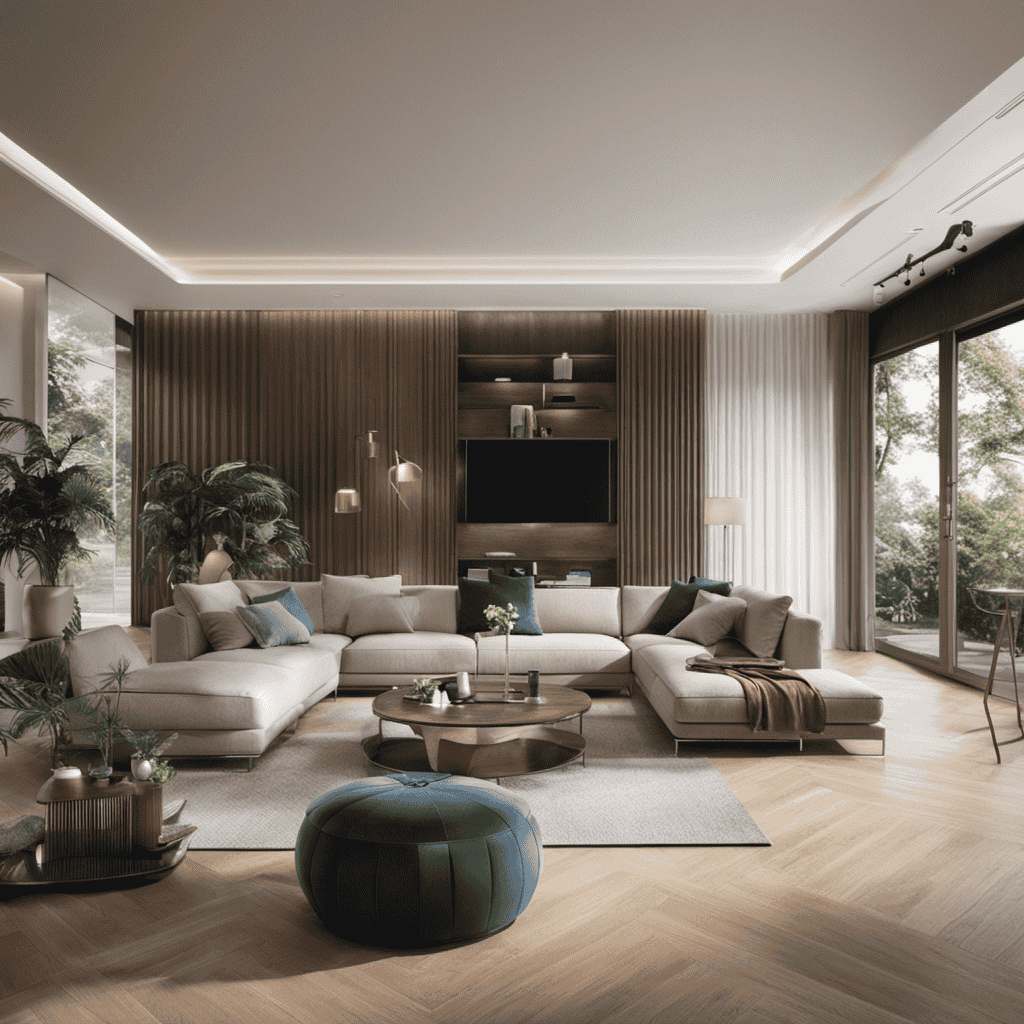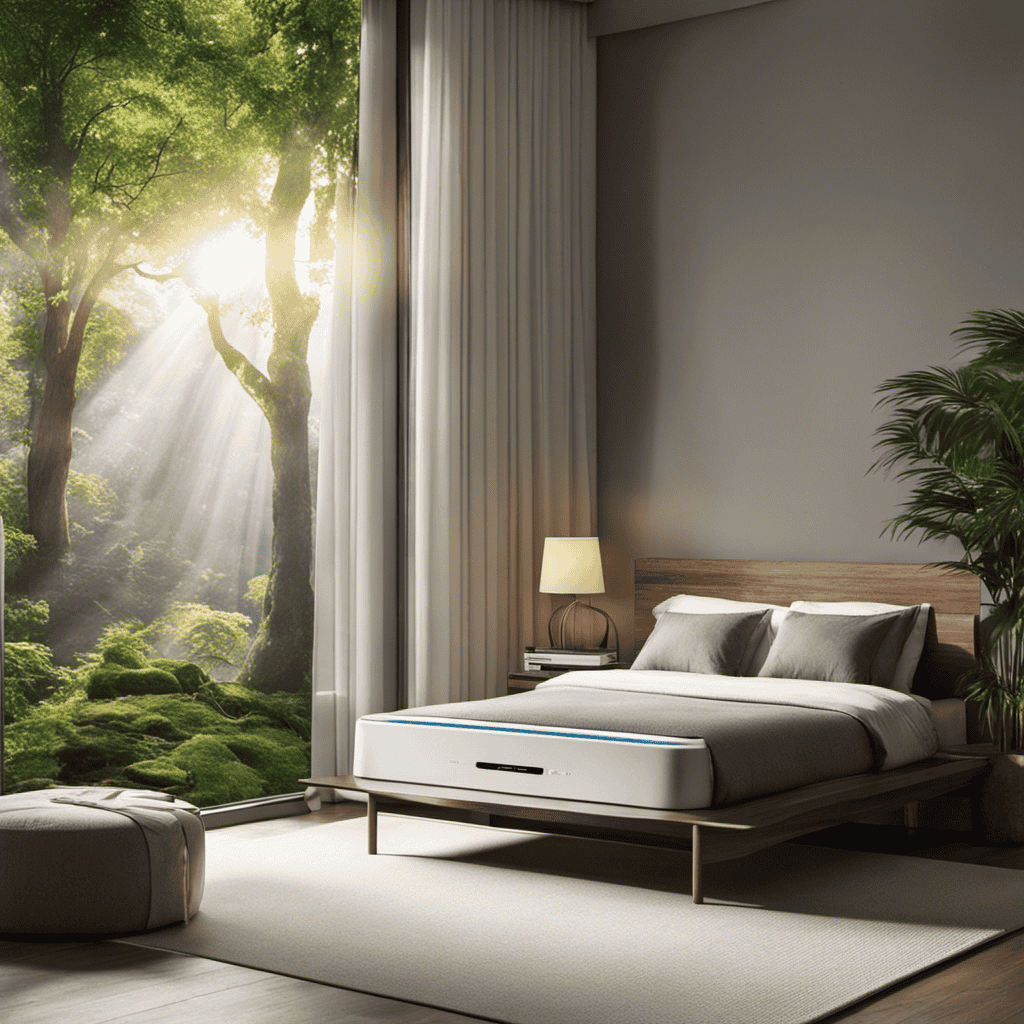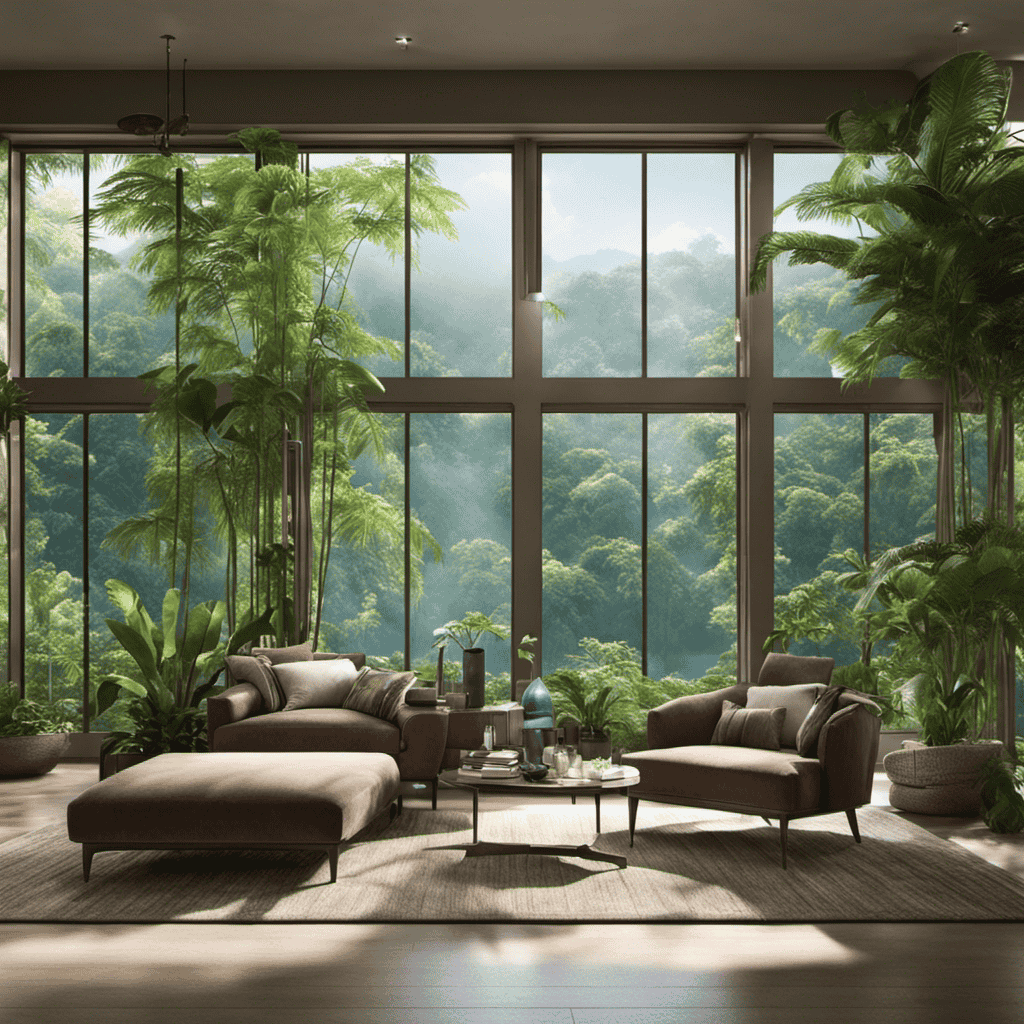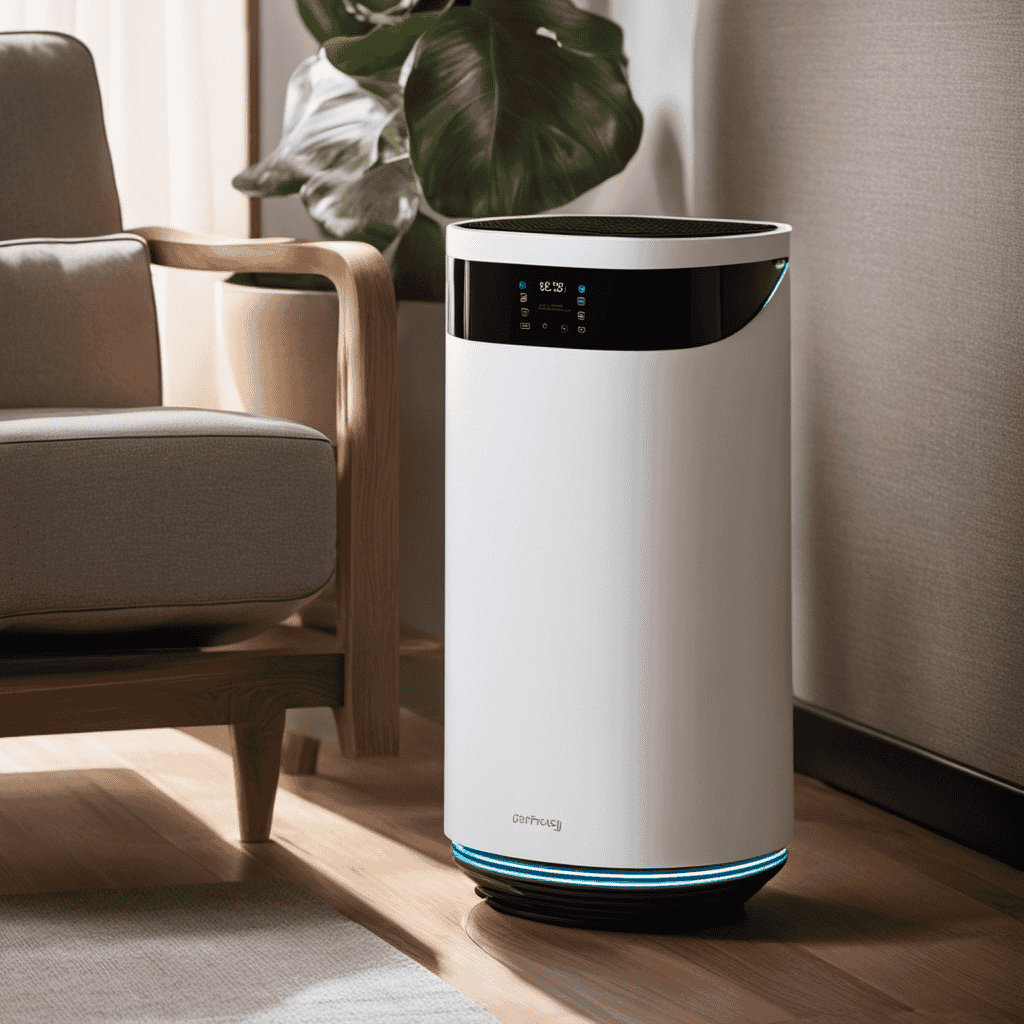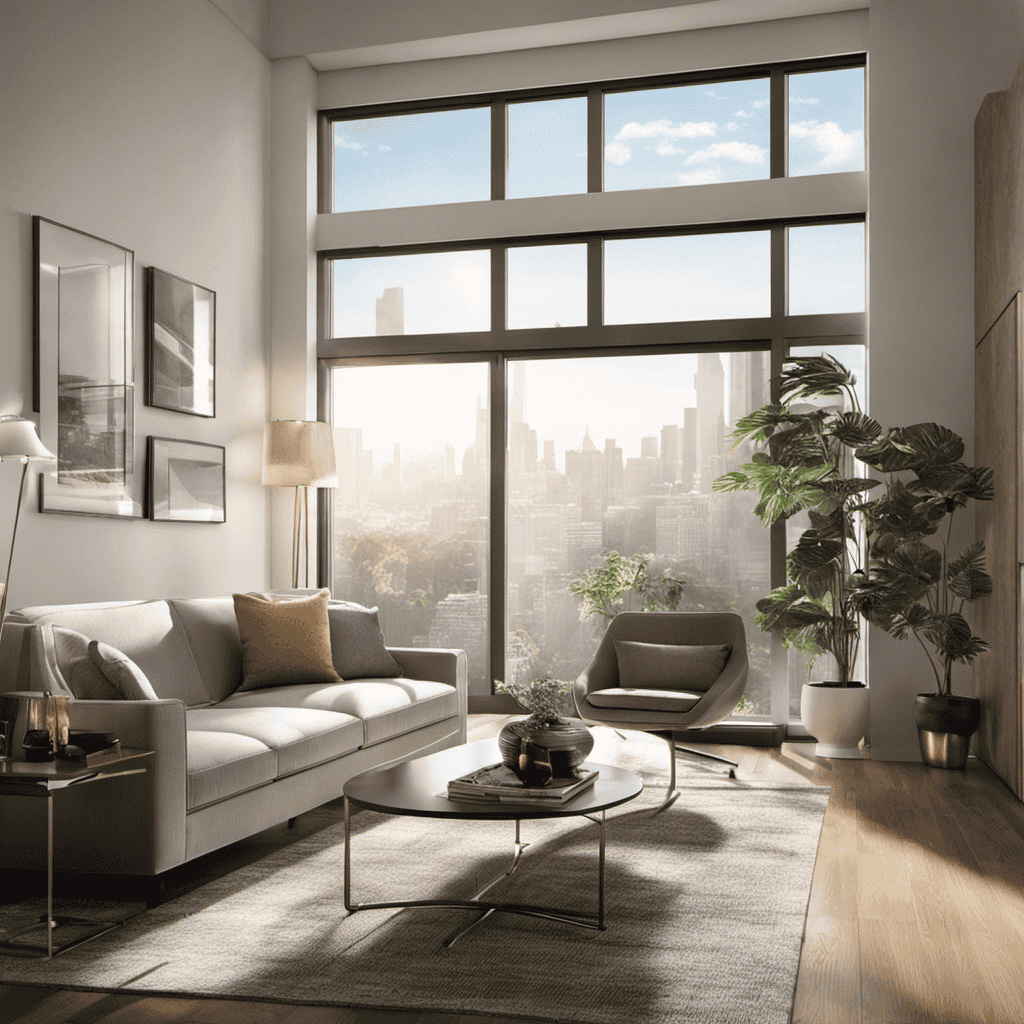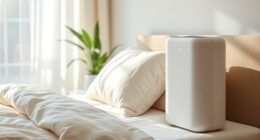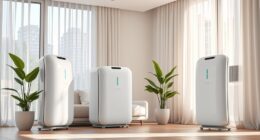I will tell you, searching for the perfect size air purifier can seem daunting. But don’t worry, my friend, I am here to assist you in navigating through the many options.
In this article, we’ll explore the factors to consider, such as room size and air purifier capacity, in order to determine just how big of an air purifier you really need.
So sit back, relax, and let’s dive into the world of clean air and optimal indoor living.
Key Takeaways
- The size of the room and its layout should be considered when choosing the right size air purifier.
- The square footage of the room, level of air pollution, and the number of air changes per hour needed should also be taken into account.
- Using an air purifier that is too small may result in poor filtration, while using one that is too large can lead to unnecessary energy consumption.
- Optimal room size directly affects the effectiveness of the air purifier, so it is important to match the air purifier capacity to the room size.
Factors to Consider in Choosing the Right Size Air Purifier
When choosing the right size air purifier, there are several factors to consider.
One important factor is the room layout. The size of the room will determine the appropriate air purifier size. For smaller rooms, a compact air purifier will be sufficient, while larger rooms will require a larger unit. It is essential to measure the dimensions of the room and choose an air purifier that can effectively cover the entire space.
Another factor to consider is the noise level. Some air purifiers can be quite noisy, which can be bothersome, especially if you plan to use it in a bedroom or office. It is recommended to check the noise level specifications and choose an air purifier that operates quietly, ensuring a peaceful environment.
Room Size and Air Purifier Capacity Relationship
When it comes to choosing the right air purifier, there are three key factors to consider.
Firstly, you need to determine the optimal room size. This refers to the square footage of the room where the air purifier will be used. The size of the room is important because it directly affects the effectiveness of the unit.
Secondly, you should make sure that the air purifier matches the capacity requirements of the room. This means selecting an air purifier with the appropriate Clean Air Delivery Rate (CADR) for the room size. By doing so, you can ensure that the air purifier will efficiently and thoroughly clean the air in the room.
Lastly, it’s important to consider the efficiency of the air purification system. This involves looking at the type of filtration system and technology used by the air purifier. The goal is to choose a system that can effectively remove pollutants and improve indoor air quality.
Optimal Room Size
To determine the optimal room size for an air purifier, you’ll need to consider factors like square footage and ceiling height. Air purifier effectiveness is closely tied to the size of the room it is intended to clean. A purifier that is too small for a room will not be able to effectively clean the air, while one that is too large may be unnecessarily expensive and consume more energy.
Room layout also plays a role in determining the optimal size, as furniture and other objects can obstruct the airflow and reduce the purifier’s effectiveness. It is recommended to measure the square footage of your room and check the manufacturer’s recommendations for the appropriate purifier size.
Matching Capacity Requirements
It’s important to match the capacity requirements of an air purifier to the size of the room in order to ensure maximum efficiency and clean air. When considering the room layout, factors such as square footage, ceiling height, and the presence of any obstacles should be taken into account.
A larger room may require a more powerful air purifier to effectively clean the air, while a smaller room may benefit from a smaller unit. Air purifier effectiveness is directly tied to its ability to circulate and filter the air within a given space.
By choosing the right capacity, you can optimize the performance of your air purifier and improve the air quality in your room.
Now, let’s explore how to achieve efficient air purification.
Efficient Air Purification
In order to achieve efficient air purification, you should ensure that the air purifier you choose is appropriately sized for the room. Here are three reasons why this is important:
-
Optimal Filtration: A properly sized air purifier will effectively filter the air in the room, removing pollutants and allergens. If the purifier is too small for the space, it may not be able to capture all the particles, reducing its effectiveness.
-
Energy Efficiency: Choosing the right size purifier ensures that it operates at its optimal efficiency. A unit that is too large for the room will consume unnecessary energy, leading to higher electricity bills. On the other hand, an undersized purifier may need to work harder, consuming more energy to achieve the desired results.
-
Longer Lifespan: When an air purifier is appropriately sized for the room, it doesn’t need to work as hard to purify the air. This reduces wear and tear on the unit, increasing its lifespan and saving you money in the long run.
Understanding Air Purifier Coverage Area
You’ll want to consider the coverage area of an air purifier to determine how big of a unit you need. Several factors affect the coverage area of an air purifier, including the size of the room, the level of air pollution, and the type of air purifier being used. Additionally, the layout of the room can impact the efficiency of the air purifier. For example, if the room has an open floor plan or large openings, the air purifier may need to have a larger coverage area to effectively clean the air. On the other hand, if the room is divided into smaller sections or has closed-off areas, a smaller air purifier may be sufficient. It’s important to consider these factors when choosing an air purifier to ensure optimal performance in your specific space.
| Factors Affecting Coverage Area | Impact of Room Layout |
|---|---|
| Room size | Open floor plan |
| Air pollution levels | Large openings |
| Type of air purifier | Divided sections |
| Closed-off areas | |
Determining the Air Exchange Rate for Effective Purification
When it comes to getting the most out of an air purifier, understanding the optimal room size is crucial.
The size of the room directly affects the effectiveness of the air purifier, as a unit that is too small will not be able to adequately clean the air, while a unit that is too large may be unnecessary and inefficient.
In addition to room size, the importance of air circulation and choosing the right capacity are also key factors to consider for optimal air purification.
Optimal Room Size
To determine the optimal room size for an air purifier, consider the square footage of the space. A larger room will require a more powerful air purifier to effectively clean the air. Here are three key factors to consider when calculating the room size for an air purifier:
-
Square footage: Measure the length and width of the room and multiply the two numbers to get the total square footage. This will give you an idea of the size of the space that needs to be purified.
-
Air purifier coverage area: Check the specifications of the air purifier you’re considering purchasing. It will typically indicate the maximum square footage it can effectively cover. Make sure the coverage area matches or exceeds the size of your room.
-
Air changes per hour (ACH): ACH refers to the number of times the air in the room is completely replaced within an hour. For optimal air purification, aim for at least 4 to 6 ACH. This will ensure that the air is continuously filtered and cleaned.
Considering the room size calculation and air purifier effectiveness, it’s also important to understand the importance of air circulation in maximizing the effectiveness of your air purifier.
Importance of Air Circulation
Ensuring proper air circulation is essential for maximizing the effectiveness of your air purifier. The importance of air filtration cannot be overstated when it comes to maintaining good indoor air quality.
However, even with the best air purifier, if there is poor air circulation in your space, the filtration process may not be as effective as it should be. Air circulation plays a crucial role in distributing clean air throughout the room, ensuring that all areas are properly filtered.
This is important because stagnant air can lead to the accumulation of pollutants and allergens, which can have a negative impact on your health. By promoting proper air circulation, you can reduce the concentration of harmful particles in the air, resulting in improved indoor air quality and better overall health.
Choosing the Right Capacity
Make sure you choose the right capacity for your space when selecting an air purifier. The size of the room and the layout play a crucial role in determining the effectiveness of the air purifier.
Here are three important factors to consider when it comes to room layout and air purifier placement:
-
Room size: Measure the square footage of your room to determine the appropriate air purifier capacity. A larger room will require a higher capacity air purifier to effectively clean the air.
-
Ceiling height: If you have high ceilings, it’s important to choose an air purifier with a higher Clean Air Delivery Rate (CADR) to ensure proper air circulation and filtration.
-
Air purifier placement: Position the air purifier in an area where it can efficiently circulate the air throughout the room. Avoid placing it near walls or furniture that may obstruct airflow.
Importance of Proper Air Purifier Sizing
Properly sizing your air purifier is crucial for effective air filtration in your space. When it comes to air quality, there are various factors that can affect it, such as the presence of allergens, pollutants, and even the size of the room itself.
Choosing the right size air purifier ensures that it can handle the specific air purification needs of your space. But did you know that the size of your air purifier can also impact energy consumption? A larger air purifier may consume more energy, resulting in higher electricity bills.
On the other hand, an undersized air purifier may have to work harder, leading to increased wear and tear and potentially shorter lifespan. It is important to strike a balance between air purifier size and energy consumption to ensure optimal air filtration and cost-effectiveness.
Common Mistakes in Selecting Air Purifier Size
When selecting an air purifier, it is crucial to consider the size of the room you intend to use it in. Room size considerations are important because the effectiveness of an air purifier is directly related to its capacity to clean the air in a given space.
Additionally, it is vital to take into account your specific air quality requirements, such as the presence of allergens, pollutants, or odors, as different purifiers are designed to target different types of contaminants.
Lastly, it’s essential to be aware of the limitations of the purifier’s capacity, as using an undersized purifier may result in inadequate air cleaning, while an oversized purifier may consume unnecessary energy without providing additional benefits.
Room Size Considerations
To determine the size of air purifier you need, you’ll want to consider the dimensions of the room where it will be placed. The room layout plays a crucial role in deciding the appropriate air purifier size. Here are some key factors to consider:
-
Room size: Measure the length, width, and height of the room to calculate the square footage. This will help determine the appropriate air purifier coverage area.
-
Noise level: Consider the noise tolerance in the room. If you prefer a quieter environment, look for air purifiers with lower noise levels.
-
Air exchange rate: Look for air purifiers that have a high Clean Air Delivery Rate (CADR). This indicates the efficiency at which the air purifier can remove pollutants from the room.
Taking these factors into account will ensure that you choose the right size air purifier for your room, providing optimal air purification and a comfortable living space.
Air Quality Requirements
One important factor to consider when choosing an air purifier is the specific requirements of your room’s air quality. To determine the right size air purifier for your room, you need to take into account the room layout and the sources of air pollution. A larger room or a room with multiple sources of pollution may require a more powerful air purifier. On the other hand, a smaller room or a room with fewer pollution sources may only need a smaller air purifier. To help you make an informed decision, consider the following table which provides a general guideline for the recommended air purifier size based on room size.
| Room Size (in square feet) | Recommended Air Purifier Size (in CADR) |
|---|---|
| Up to 200 | 100-150 |
| 201-400 | 150-250 |
| 401-600 | 250-350 |
| 601-800 | 350-450 |
Purifier Capacity Limitations
The capacity of an air purifier is limited by the size of the room and the sources of pollution. To ensure the effectiveness of your air purifier, consider the following:
-
Room size: Larger rooms require air purifiers with higher CADR (Clean Air Delivery Rate) to effectively clean the air. Measure the square footage of your room to determine the appropriate purifier capacity.
-
Pollutant sources: Identify the main sources of pollutants in your room. If you have pets or live in a city with high outdoor pollution, you may need a more powerful purifier to remove these contaminants.
-
Purifier placement: Proper placement of the air purifier is crucial for optimal performance. Place the purifier in a central location, away from obstructions, and ensure proper airflow around it.
Considering these factors will help you select the right size air purifier for your room. In the next section, we will discuss how to measure room size for air purifier calculation.
How to Measure Room Size for Air Purifier Calculation
Measuring room size for air purifier calculation is essential to ensure you select the right size unit.
To calculate the size of air purifier needed for your room, you need to determine the square footage of the area. Start by measuring the length and width of the room using a tape measure. Multiply these two measurements together to get the total square footage.
Once you have the square footage, you can refer to the recommended air purifier size chart provided by manufacturers. This chart will guide you in selecting the appropriate air purifier for your room size.
It is important to note that if your room has high ceilings or is connected to other rooms, you may need to consider these factors when calculating the air purifier size.
Matching Air Purifier Size to Your Indoor Air Quality Needs
When matching the size of an air purifier to your indoor air quality needs, there are several factors that can affect its performance. Here are three key considerations to keep in mind:
-
Room Size: The size of the room plays a crucial role in determining the appropriate air purifier size. A larger room will require a more powerful purifier to effectively clean the air.
-
Air Quality Requirements: Different air purifiers are designed to target specific pollutants, such as allergens, smoke, or odors. Assessing your specific air quality needs will help you select an air purifier that can effectively address those concerns.
-
Cost Considerations: The size of the air purifier can also impact its cost. Generally, larger air purifiers with higher clean air delivery rates tend to be more expensive. It’s important to balance your air quality needs with your budget to find the right match.
Benefits of Using a Correctly Sized Air Purifier
To maximize the effectiveness of your correctly sized air purifier, make sure to regularly clean or replace the filters. Proper air purifier sizing is crucial in ensuring that you achieve the best indoor air quality. Factors to consider in choosing the right size air purifier include the square footage of the room, the level of air pollution, and the number of air changes per hour needed. It is important to note that using an air purifier that is too small for the room will result in poor filtration, while using one that is too large may lead to unnecessary energy consumption.
Here is a table summarizing the recommended air purifier sizes based on room square footage and the Clean Air Delivery Rate (CADR):
| Room Size (Square Footage) | CADR (Cubic Feet per Minute) | Recommended Air Purifier Size |
|---|---|---|
| Up to 150 | 60-100 | Small |
| 150-300 | 100-200 | Medium |
| 300-450 | 200-300 | Large |
| 450-600 | 300-400 | Extra Large |
| Over 600 | Over 400 | Multiple Large Purifiers |
Adjusting Air Purifier Size for Different Room Configurations
If you have rooms with different configurations, it’s important to consider the layout and airflow when selecting the size of your air purifier. Adjusting air purifier placement can help maximize its effectiveness in different room setups. Here are three key factors to consider:
-
Room size: Measure the square footage of the room and choose an air purifier that can effectively cover that area. A larger room may require a higher CADR (Clean Air Delivery Rate) to ensure proper air circulation.
-
Ceiling height: If you have high ceilings, it’s important to select an air purifier with a higher airflow capacity. This will help ensure that the purified air reaches all corners of the room.
-
Furniture placement: Obstacles like furniture, curtains, or shelves can hinder the airflow of an air purifier. Make sure to place the unit in an open area with minimal obstructions for optimal performance.
Professional Advice on Determining the Ideal Air Purifier Size
For optimal performance, consider seeking professional advice on determining the ideal size of your air purifier. Factors affecting air purifier efficiency can vary depending on the size of the room and the specific needs of the individuals using the space.
A professional can assess these factors and provide personalized guidance on selecting the right size air purifier for your needs. It’s important to note that improper sizing can lead to reduced efficiency and effectiveness of the air purifier.
Additionally, proper maintenance is crucial for ensuring optimal performance. Regularly cleaning or replacing filters, as well as keeping the unit clean and free from dust and debris, can greatly impact the efficiency and lifespan of your air purifier.
Seeking professional advice and practicing proper maintenance will ensure that your air purifier operates at its best, providing clean and healthy indoor air.
Frequently Asked Questions
Can I Use a Small Air Purifier in a Large Room?
I don’t recommend using a small air purifier in a large room. It may not be effective enough to clean the air properly. Consider getting a larger purifier that can handle the size of the room.
How Do I Calculate the Appropriate Air Purifier Size for a Room With High Air Pollution Levels?
To calculate the appropriate air purifier size for a room with high air pollution levels, I’d consider the room’s square footage, the CADR rating of the purifier, and the recommended ACH (air changes per hour) for different pollution levels.
What Are the Consequences of Using an Oversized Air Purifier in a Small Room?
Using an oversized air purifier in a small room can lead to wasted energy and inefficient air cleaning. It may not effectively remove pollutants, and could even create discomfort due to excessive noise or airflow.
Is It Necessary to Adjust the Air Purifier Size for Rooms With Open Floor Plans?
Adjusting air purifier size for open floor plan rooms can optimize energy consumption. Alternative solutions, such as strategically placing multiple smaller purifiers, can also improve air quality.
How Can I Determine the Ideal Air Purifier Size for a Room With Multiple Entry Points?
When considering air purifier placement, it’s important to factor in the room’s size and layout, especially if it has multiple entry points. This ensures effective air circulation and determines the ideal air purifier size.
Conclusion
In conclusion, choosing the right size air purifier is crucial for effective purification and improving indoor air quality. By understanding the relationship between room size and air purifier capacity, as well as considering factors like air exchange rate and coverage area, you can ensure that you have the perfect fit for your needs.
Using a correctly sized air purifier brings numerous benefits, including cleaner air and reduced allergies. Don’t hesitate to seek professional advice to determine the ideal air purifier size for your specific room configuration.
Take control of your indoor air quality today!
